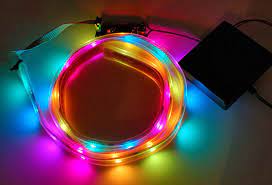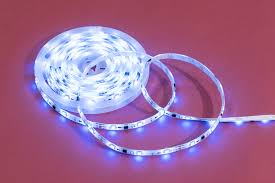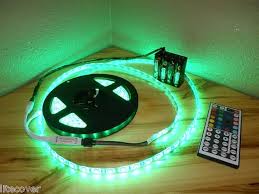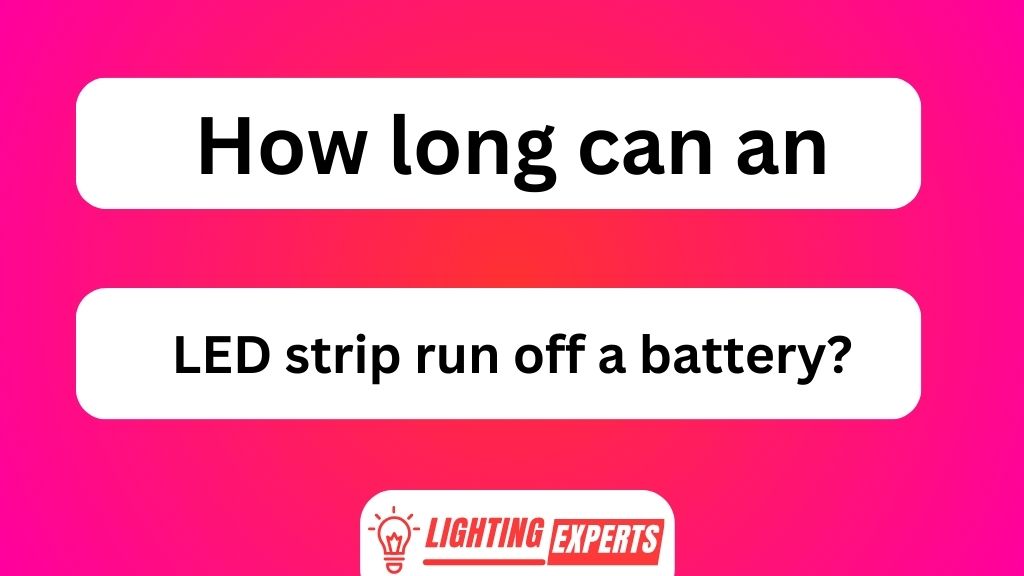Ever wondered how long an LED strip can run off a battery? Well, buckle up because we’re about to dive into the electrifying world of LED strip battery life.

From factors affecting runtime to calculating power consumption, we’ve got you covered. We’ll even reveal the best batteries for your LED strips and share tips on extending their battery life.
So get ready to shed some light on this illuminating topic with us!
Key Takeaways of How Long Can an LED Strip Run off a Battery?
- The brightness level of the LED strip affects the battery life.
- The type of battery used (alkaline, lithium-ion, rechargeable) impacts the duration of the LED strip.
- Certain LED strip patterns consume more energy and drain the battery faster.
- The LED strip’s runtime depends on factors such as voltage, battery capacity, LED strip length, brightness level, and usage patterns.
Factors Affecting LED Strip Battery Life
To maximize your LED strip battery life, you’ll want to consider factors such as brightness level and pattern selection.
The type of battery you use plays a significant role in determining the duration of your LED strip’s operation. There are different battery types available, including alkaline, lithium-ion, and rechargeable batteries. Alkaline batteries are commonly used but may have a shorter lifespan compared to lithium-ion or rechargeable options.

Optimal battery usage involves selecting the appropriate brightness level for your needs. Higher brightness settings consume more power and drain the battery faster.
Additionally, choosing certain patterns for your LED strip can also impact battery life. Flashing or color-changing patterns tend to use more energy compared to static or single-color displays.
Battery Capacity and LED Strip Runtime
When considering the battery life expectancy of an LED strip, it is crucial to examine factors such as power consumption and runtime. LED strips vary in their energy requirements depending on the number of LEDs and their brightness levels.

Additionally, factors like voltage, battery capacity, and usage patterns can significantly affect how long an LED strip can run off a battery before requiring a recharge or replacement.
Battery Life Expectancy
The battery’s life expectancy depends on how long the LED strip is running. When the LED strip is connected to a battery, it starts to discharge power from the battery. The amount of power discharged depends on factors such as the length of the LED strip, its brightness level, and any additional features like color-changing or flashing modes.

Battery longevity can vary greatly depending on these factors. Generally, larger LED strips that require more power will drain the battery faster and reduce its overall lifespan. It’s important to consider these factors when planning how long you want your LED strip to run off a battery.
To extend battery life, you can choose a more efficient LED strip or use a larger capacity battery for longer runtime.
LED Strip Power Consumption
Consider using a more efficient LED strip and a larger battery for longer usage time. When it comes to LED strip power consumption, it’s essential to ensure that the battery you choose can meet the voltage requirements of the strip. LED strips generally operate at low voltages, usually 12V or 24V. Therefore, selecting a battery with the corresponding voltage output is crucial to ensure proper functioning.
Additionally, consider the capacity of the battery in terms of Ah (ampere-hours). A larger capacity battery will provide more runtime before needing to be recharged or replaced. By carefully considering both the voltage requirements and capacity of your chosen battery, you can optimize the runtime of your LED strip setup.
Now let’s delve into factors that affect runtime in more detail.
Factors Affecting Runtime
Using a more efficient LED strip and a larger battery can impact the runtime of your setup. When considering how long an LED strip can run off a battery, several factors come into play.
- Battery type: The type of battery used greatly affects the runtime. Lithium-ion batteries tend to have higher energy densities and longer lifespans compared to other types like alkaline or nickel-metal hydride.
- Voltage requirements: LED strips typically require a specific voltage to operate optimally. Choosing a battery with the appropriate voltage ensures efficient power delivery and extends the runtime.
- Power consumption: The power consumption of the LED strip itself is another critical factor. A more energy-efficient strip will consume less power and therefore prolong the runtime.
- Battery capacity: The capacity of the battery, measured in milliampere-hours (mAh), determines how much charge it can store. A higher-capacity battery will provide longer runtime before needing recharging.
Calculating LED Strip Power Consumption
To calculate the power consumption of your LED strip, you’ll need to know the voltage and current rating. The power requirement of an LED strip can be calculated using Ohm’s law, which states that Power (P) equals Voltage (V) multiplied by Current (I).
Therefore, to determine the power requirements, multiply the voltage rating of your LED strip by its current draw. For example, if your LED strip has a voltage rating of 12 volts and a current draw of 1 ampere, the power consumption would be 12 watts.
It is crucial to consider these calculations when choosing a power source for your LED strip to ensure compatibility and prevent any potential issues such as overheating or inadequate brightness.
Best Batteries for Running LED Strips
When it comes to running LED strips, understanding battery lifespan is crucial. We need to consider the trade-off between battery capacity and battery life.
Additionally, the decision of whether to use rechargeable or disposable batteries can greatly impact the overall performance and longevity of the LED strips.
Battery Lifespan and LED Strips
LED strips can typically run for several hours off a battery before needing to be recharged. To optimize battery performance and extend the lifespan of your LED strip, it is crucial to follow proper battery maintenance practices. Here are some tips:
- Regularly check the battery voltage to ensure it is within the recommended range.
- Avoid completely draining the battery as this can shorten its overall lifespan.
- Store batteries in a cool and dry environment to prevent damage or leakage.
- Use a compatible charger that provides the correct voltage and current for optimal charging.
By following these guidelines, you can maximize your battery’s longevity and ensure uninterrupted operation of your LED strip.
Now let’s delve into the concept of capacity vs. battery life, which will further enhance our understanding of how long an LED strip can run off a single charge.
Capacity Vs. Battery Life
By understanding the relationship between capacity and battery life, you can make informed decisions about how to maximize the usage time of your LED strip. Battery capacity limits refer to the amount of energy that a battery can store, which directly affects how long your LED strip can run on a single charge.
To optimize power usage, it is essential to know the power consumption rate of your LED strip and match it with a battery that has sufficient capacity. If the battery’s capacity is too low, the LED strip may not run for as long as desired, while a high-capacity battery may be unnecessary and bulky.
Finding the right balance between power consumption and battery capacity will ensure efficient use of your LED strip without compromising its performance.
Now let’s explore whether rechargeable or disposable batteries are more suitable for powering an LED strip.
Rechargeable or Disposable?
To determine the most suitable option for powering your LED strip, you should consider whether rechargeable or disposable batteries would be more beneficial.
Here are some pros and cons to help you make an informed decision:
- Rechargeable Batteries:
- Pros:
- Can be recharged multiple times, reducing waste
- Cost-effective in the long run
- Higher energy density, providing longer battery life
- Environmentally friendly
- Cons:
- Initial cost is higher than disposable batteries
- Limited number of charge cycles before performance declines
- Disposable Batteries:
- Pros:
- Convenient and widely available
- No need for charging infrastructure
- Lower initial cost compared to rechargeable batteries
- Cons:
- Generate more waste since they cannot be recharged
- Higher long-term cost due to frequent replacements
Consider these factors when choosing between rechargeable and disposable batteries for your LED strip, keeping in mind your budget and environmental impact.
Extending LED Strip Battery Life
If you want to make your LED strip battery last longer, try reducing the brightness level. Maximizing battery performance and conserving power are crucial when using LED strips with batteries.
Lowering the brightness level not only saves energy but also extends the overall runtime of your LED strip. By reducing the brightness, you decrease the power consumption, allowing the battery to last for a longer period.
It is important to find a balance between brightness and battery life that suits your needs. In the next section, we will provide tips for efficiently using LED strips with batteries to help you get the most out of your lighting setup while preserving battery life.
Tips for Efficiently Using LED Strips With Batteries
You can maximize the lifespan of your LED strip battery by implementing these efficient tips:
- Optimize brightness levels: Adjust the brightness of your LED strip to a lower setting, as higher brightness requires more power.
- Utilize timers or motion sensors: Use timers or motion sensors to automatically turn off the LED strip when not in use, conserving battery power.
- Choose energy-efficient LEDs: Select LED strips with high energy efficiency ratings to reduce power consumption.
- Consider battery capacity: Use batteries with larger capacities to ensure longer runtime for your LED strip.
By following these tips, you can achieve efficient power usage and maximize the battery life of your LED strip.
Now let’s move on to testing the runtime of LED strips with different batteries.
Testing LED Strip Runtime With Different Batteries
Using various batteries, we can test the runtime of LED strips and compare their performance. Battery performance is crucial when it comes to powering LED strips, as it determines how long they will stay illuminated. By conducting battery testing, we can gain valuable insight into which types of batteries are most suitable for powering LED strips. This information allows us to make informed decisions about which batteries to use in different scenarios.
It is important to consider factors such as battery capacity and voltage output during these tests, as they directly impact the runtime of the LED strip. Understanding battery performance through testing ensures that we can choose the most efficient power source for our LED strips.
Now let’s explore how to safely power LED strips with batteries…
How to Safely Power LED Strips With Batteries
To safely power your LED strips with batteries, make sure to follow proper wiring procedures and use the correct voltage for your specific strip. Here are some important safety precautions and power management techniques to keep in mind:
- Choose the right battery: Select a battery that can provide enough power for your LED strip and has the appropriate voltage rating.
- Use a current-limiting resistor: This will help regulate the current flowing through your LEDs and protect them from damage.
- Implement proper insulation: Insulate all connections to prevent short circuits or electrical shocks.
- Consider using a voltage regulator: This will ensure a stable power supply and prevent overvoltage situations.
Troubleshooting Battery Drain Issues With LED Strips
If experiencing battery drain issues with your LED strips, it may be helpful to check for any loose connections or faulty wiring. Ensuring proper installation can prevent unnecessary power loss and extend the battery life of your LED strips. Here are some troubleshooting tips to prevent battery drain:
| Troubleshooting Tips | Description |
|---|---|
| Check for Loose Connections | Ensure all connections between the battery, LED strips, and any connectors are secure and tight. |
| Inspect Wiring for Damage | Examine the wiring for any signs of wear or damage that could be causing a short circuit or power leakage. |
| Use High-Quality Batteries | Opt for high-quality batteries with longer lifespan to maximize the runtime of your LED strips. |
| Reduce Power Consumption | Dimming the brightness level or using only necessary features can help conserve battery power. |
| Consider External Power Source | If possible, connect your LED strips to an external power source to eliminate reliance on batteries. |
Frequently Asked Questions
Can I Use Any Type of Battery to Power an LED Strip?
Yes, you can use different types of batteries to power an LED strip. However, it is important to consider the optimal battery capacity for LED strips to ensure sufficient power and longer runtime.
How Long Will an LED Strip Run off a 9V Battery?
LED strip brightness levels and battery voltage requirements determine how long an LED strip can run off a battery. It is essential to consider these factors to accurately estimate the runtime of an LED strip powered by a 9V battery.
Can I Connect Multiple LED Strips to One Battery?
Connecting multiple LED strips to one battery is possible by wiring them in parallel. However, doing so will decrease the overall battery life. To extend it, consider using a higher capacity battery or adding a power source with regulated voltage.
Is It Safe to Leave an LED Strip Powered by a Battery Unattended?
When leaving an LED strip powered by a battery unattended, it is crucial to take fire safety precautions. The battery’s capacity directly affects the longevity of the LED strip’s operation.
How Can I Conserve Battery Life When Using LED Strips?
To conserve battery life when using LED strips, we employ various techniques. By implementing optimal usage duration and employing battery saving methods, such as dimming the brightness or utilizing power-saving modes, we can extend the longevity of the battery.
Conclusion
In conclusion, it is evident that LED strips can run off batteries for a considerable amount of time with proper planning and efficient usage. By exploring the factors affecting LED strip battery life, calculating power consumption, and determining the best batteries for running LED strips, users can enjoy extended runtime.
By following the tips provided and troubleshooting any potential battery drain issues, users can ensure that their LED strips last even longer. So go ahead and light up your space with these energy-efficient beauties – they’re a real game-changer!




